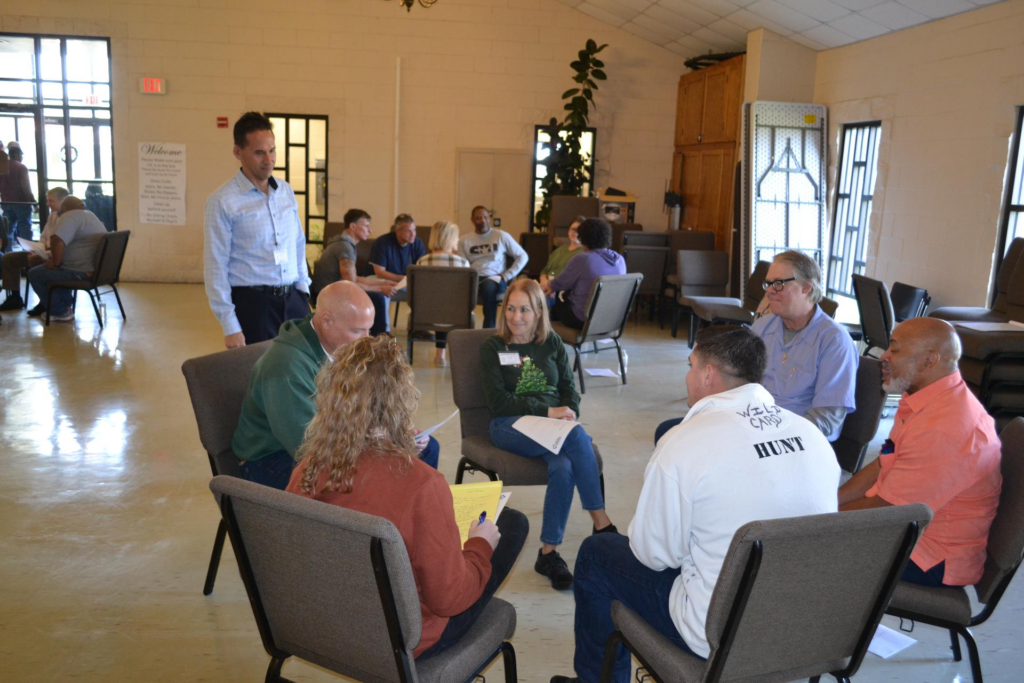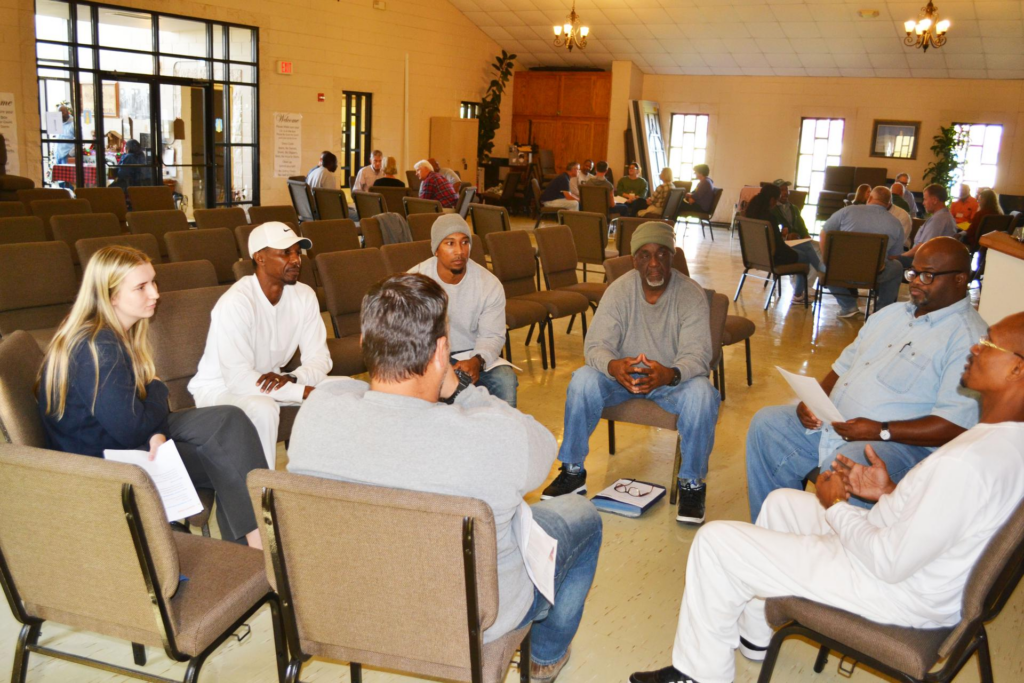
Parole Project recently partnered with the Frederick Douglass Project for Justice with the goal of changing the narrative surrounding the justice system, and incarcerated persons, and ultimately influencing meaningful change in policy and in our communities. Louisiana is now the fourth state in which the project, led by Georgetown University law professor Marc Howard, has introduced its prison visit program. It is designed to give lawmakers, leaders, and everyday Americans an opportunity to witness the humanity of incarcerated people. Two sessions were hosted in December at Elayn Hunt Correctional Center in St. Gabriel to kick off the project, with plans to continue the visits twice monthly.
At each session, the visitors are given a guided tour of the Hunt facilities, including the education center, law library, and housing areas. At each location, they are given a brief overview of the role staff and residents play in rehabilitation programs, and initiatives developed that allow individuals to better themselves while in prison. Hunt Deputy Warden Darryl Campbell explains it this way:
“These aren’t people who have been arrested for small things like shoplifting. They made a mistake years ago, and they are being punished because of it, but they have shown they can change. They are rehabilitating themselves and are no more a threat than anyone in this group. They aren’t trying to pretend it didn’t happen – just to be seen as people like you and me.”

The meeting is held in the prison’s chapel where approximately 20 incarcerated men – some eager, some nervous – await the “free people” they are about to meet. The group varies in age, time served, and background, but each man has been selected for their demonstrated leadership and rehabilitation while incarcerated. As the tour files in, the men in the chapel stand and greet them before everyone finds a seat in a large circle in an alternating sequence of insiders and outsiders.
With the two groups now merged into one, facilitators begin with a summary of the project’s goals. Each member of the circle introduces themselves to the rest of the group by sharing their name, hometown, and answering an icebreaker question such as “What is the best compliment anyone has given you?” or “What is the best holiday gift you have ever received and why?”
Now acquainted, the circle is numbered off before breaking into smaller groups where they build deeper connections with each other. In groups of six, the free people and incarcerated men answer discussion questions about their lives, hopes, or feelings to discover commonalities and learn how they are more similar than they are different.
Finally, the small groups return to a large circle, this time somewhat more open than apprehensive as strangers have become friends. With an open floor, the circle members are asked to share their thoughts – ranging from simple facts they learned about their small group partners to reflections on how the visit has changed their perspectives.
In both December sessions, the final reflection proved emotional for several members of the group. For the free people, revelations of humanity within the walls of the prison have been powerful:
- “Our problems and things we want to change are similar – it felt like I was talking to a group of friends I’ve known for years.”
- “We aren’t related, but we’re all family – families have to forgive, move forward, and grow.”
- “We need to get more people in here, let them sit down, and see how much we have in common.”
It’s not just the free people who walk out of the session changed. The incarcerated men also shared the impact the discussions had on them:
- “Today brought closeness and unity with people I never thought would understand me. I realized people outside have the same passion to help inmates as the guys inside … and together, our passion can do some amazing things.”
- “If you can’t engage with people, you can’t figure out what the problem actually is. You can speculate but until you hear it from them … you’ll never know what they are actually experiencing.”
- “We forget that people out there are human too. They hurt. They have things they struggle with. We have to remember that – it’s not that they don’t care or are all think they’re better than us … they’re trying to figure life out too.”
- “Today I found out that there are still people that care, that want to see me succeed, and believe that I can earn a second chance.”
- “I’m taking this experience back to the dorm and sharing it with everyone. Change is coming and this is the first step.”
- “The more curious people are and the more questions they ask, the more they see us as humans … and not just a DOC number or a crime.”
- “We know our family and loved ones care about us, but to see free people taking the time to come engage with us – people you don’t even know … that means the world to us. It gives us newfound hope to go on and shows that we’re not just forgotten by society.”
Each session ends with a call to action: that the participants, from inside and outside, talk about the experience, and the conversations they participated in, and get more people involved to ensure future sessions.
As the circle thins out, the farewells are a sharp contrast from the timid handshakes and nervous smiles that walked in. When the last free people leave, the incarcerated men instinctively move the chapel’s chairs back into their usual seating position, making sure it is ready for the weekend’s services.
For more information on the Frederick Douglass Project, visit DouglassProject.org.
If you are interested in participating in future sessions, please contact Matt Pineda or Christi Cheramie via email at matthew@paroleproject.org or christi@paroleproject.org, respectively.
Special thanks to the Frederick Douglass Project and Elayn Hunt Correctional Center for providing photos from the December 2 session and to everyone who participated in these first two sessions.



